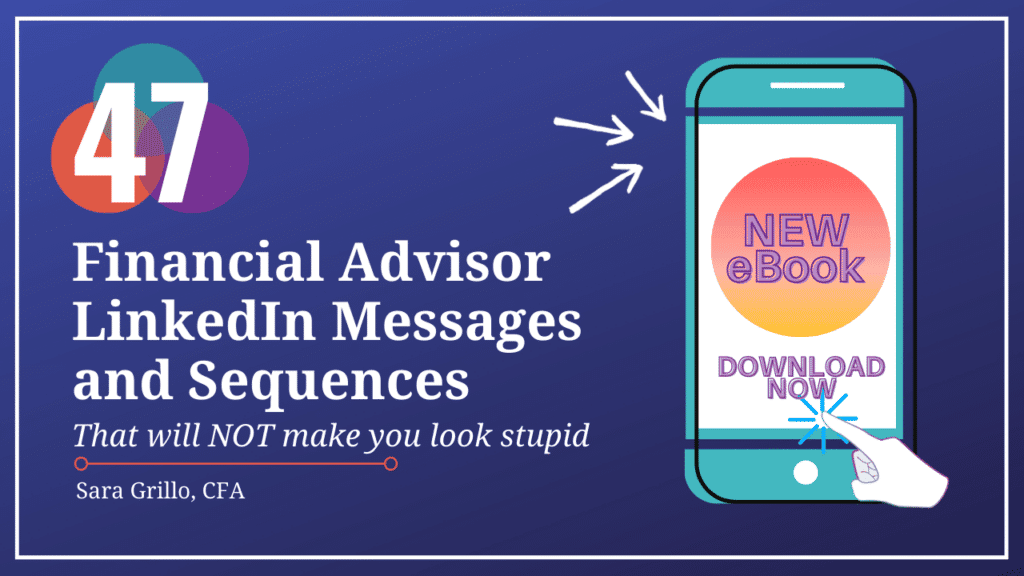Podcast: Play in new window | Download
It seems like financial advisors and cryptocurrency are like oil and water. Your clients are probably going to be asking about this, if they haven’t already, so let’s break this open and talk about the major aspects of how financial advisors can add cryptocurrency to a client’s portfolio.
We’ll learn:
- What is a fiat currency?
- What is cryptocurrency?
- What is Blockchain?
- What is an NFT?
- What is a Blockchain miner?
- What is the case for investing in digital assets?
- What are the issues and obligations for advisors who want to invest in crypto for their clients?
- How can financial advisors potentially invest in cryptocurrency for their clients?
- How do you see the future of Cryptocurrency and Digital Currency in people’s daily life?
- Should Bitcoin as an asset allocation have the same rebalancing strategy (tolerance bands or time interval) as other holdings?
For those of you who are new to my blog/podcast, my name is Sara. I am a CFA® charterholder and financial advisor marketing consultant.
I have a weekly newsletter in which I talk about financial advisor lead generation topics which is best described as “fun and irreverent.” So please subscribe!
Let’s get on with the blog!
Financial advisors and cryptocurrency, and never the twain shall meet
This podcast interview features A.J. Nary of HeightZero which is a turnkey digital asset management platform (TDAMP). I wanted to make a podcast about how financial advisors can add cryptocurrency to a client’s portfolio because I feel like there is alot of trepidation about this issue – but also a great deal of curiosity.
In a recent LinkedIn survey I did about when financial advisors expect to invest in cryptocurrency for their clients, I found that most think that cryptocurrency is too dangerous to invest in on behalf of clients, or won’t do it until they learn more about it.
But before we get started, I want to be clear that nothing in this podcast or blog can be interpreted as an investment recommendation of any type. I have no financial affiliation with any company mentioned in this podcast. Do your own research before investing and do not interpret anything in this blog or podcast to be a recommendation specific to you or any clients of yours. Also, nothing in this blog or podcast can be interpreted as legal or compliance advice.
Cryptocurrency terms for financial advisors to know
Before we get into the discussion of how financial advisors can add cryptocurrency to a client’s portfolio, let’s start with some basic definitions.
- What is money?
- What is a fiat currency?
- What is Bitcoin?
- What is Blockchain?
- What is an NFT?
- What is a Blockchain miner?
Money: Money is a medium of exchange whose value has traditionally been transferred as payment for goods or services from one party to another through coins and bills.
Fiat currency: Way back in days of yore, the dollar was pegged to gold. Then FDR made the dollar unpegged to gold. You could create extra money without creating any underlying value to go with it. Nixon did away with the gold standard 100%, and the US dollar became a fiat currency, backed only by the full faith and taxing authority of the US government.
Blockchain: Blockchain is not some mythical creature like Narnia. It’s simply a shared database with many actors. If you were to walk into a bank and deposit $100 and the transaction were on the Blockchain, they would write an entry into that database. Another bank on the Blockchain could also see it. Other banks could verify that transaction. That’s all Blockchain is, a shared database.
There are private blockchains, and public blockchains. The example described above is a private blockchain. They are in production at the time of this podcast. Examples of public blockchain would be Bitcoin and Ethereum where if you have a computer and an internet connection, you can download all the transactions that are on the Bitcoin blockchain. You can see on there a transaction from one wallet to another public wallet with a time stamp. It is as if you gave someone $20 on the street, and there are 10,000 people witnessing that transaction.
Blockchain miner: Someone who approves Bitcoin transactions. Imagine there are 10 people sitting in a room, and they’re all sitting at a desk with a 1,000 piece puzzle in front of them. Eventually someone is going to solve that puzzle. Once that is done, everyone can look at the puzzle and say, “Oh yes, that’s a square.” Everyone can agree it’s a square, but solving the puzzle is extraordinarily difficult and expensive.
The Blockchain miners do not hold the digital assets; a custodian does. Or, you could have your own hardware wallet which for the record A.J. does not recommend. The latter case is commonly referenced when you hear stories about people losing their money because they forget their passkey.
Cryptocurrency: A digital currency that is encrypted and decentralized (not relying on what the central bank does). There are many different types of cryptocurrencies such as Bitcoin, Ripple, and Ethereum. Not all cryptocurrencies are created equal – the security, regulation, and history involved with each are worthy for investors to take note of.
Just like any capital market instrument, a cryptocurrency’s value changes based upon supply and demand for the asset.
Bitcoin: See definition of Blockchain above.
NFT: Non fungible token. Several decades ago, people were ripping off music during the Napster era and there was no way to prove that you were the only person who owns that digital asset. There was no way to make it scarce.
An NFT is a digital asset that sits on a Blockchain. It could represent something physical like art, or it could represent a digital file like a famous tweet. You are the only one with that item.
TDAMP: Turnkey digital asset management platform. A technology platform that allows investors to invest in digital assets. You have an account on this platform that is reported upon, and data from the platform can be exported into other systems.
Why would someone invest in cryptocurrency for themselves or for their clients?
Before we get into how financial advisors can add cryptocurrency to a client’s portfolio, let’s talk about why financial advisors (and the world at large, it seems) is curious about cryptocurrency. While performance of any asset can never be guaranteed, and nothing in this blog and/or podcast can be interpreted as investment advice relevant to anyone specific, there is a belief that cryptocurrencies are going to change the way that society functions in three major ways.
#1 Store of value/universal currency of exchange
Some people believe that banks and governments can’t be trusted, and cryptocurrencies are potentially going to be the new global reserve currency with goods and services being priced in cryptocurrency. Companies and people are starting to use cryptocurrency as a store of value.
#2 Inflation hedge
There is an idea prevailing that fiat currencies are being devalued and inflation is due to rise, as a result of all the stimulus money that has been printed and other economic factors. There is a finite amount of Bitcoin, for example, that can be created.
#3 Potentially low correlation to the market
Cryptocurrencies have become attractive to some as a potentially diversifying alternative investment because of their alleged zero correlation to the market. Such diversifying investments can potentially lower overall portfolio volatility, if managed appropriately in accordance with the investor’s risk tolerance.
#4 Some financial advisors have found that being knowledgeable about investing in cryptocurrency is a way to bridge the gap with younger generations of their clients’ families.
All of these are potential ways that cryptocurrency may have an impact in the future – none of them are certain.
What are the issues and obligations for advisors who want to invest in cryptocurrency for their clients?
As a financial advisor, you have responsibility to manage your clients’ assets prudently. If you are going to be investing in cryptocurrency for your clients, consult with your compliance and/or legal council and be aware of your obligations. Being prepared and through before doing so is a big part of the answer to how financial advisors can add cryptocurrency to a client’s portfolio.
Here are some of the issues to be aware of for financial advisors who are potentially investing in cryptocurrency for their clients. This is not an exhaustive list; there are others that may potentially exist.
#1 Check your errors and omissions insurance
Make sure investing in cryptocurrency for your clients is covered in your e&o insurance policy and any other insurances where this may apply. Make a phone call if you’re not sure. Some policies cover this already, and some don’t.
#2 Educate yourself about digital assets
Part of your responsibility is knowing what you are investing in for your clients in all circumstances. You must have a reasonable basis for making these and all other investments on behalf of your clients. You also need to be able to articulate and explain these investments to your clients in a way that enables them to understand clearly.
#3 Understand that not all digital assets are created equally
With certain cryptocurrencies, there is a gray area in terms of regulations that pertain to them. Some more than others. It may be more prudent to stick to cryptocurrencies that the SEC has already deemed as appropriate for investment.
#4 Encourage clients to report it correctly on their taxes
Ask your clients if they hold cryptocurrency, and if so, encourage your clients to report any tax events associated with cryptocurrencies when they file their taxes. Cryptocurrencies are treated as property. Just like any asset, an individual will be liable to potentially owe a short or long term gains tax if they recognized a gain over the cost basis that cryptocurrency was purchased at.
If your clients are at a loss to understand how to report cryptocurrency on their taxes, encourage them to consult a tax advisor.
#5 Disclose properly on Form ADV, especially Part Two
Digital assets are not necessarily one of the investable asset classes disclosed on your ADV. On your Form ADV, Part Two, there is a list of investments that you are able to invest your clients’ money in as a financial advisor. Have your legal and/or compliance team review it and determine the best way to disclose that you are able to invest your clients’ money in digital assets.
Again, this list is by no means exhaustive and may not be interpreted as specific to any one individual, so please consult your firm’s legal and compliance advisors for advice.
Should the same rebalancing strategy (tolerance bands or time interval) be applied to cryptocurrency as an asset allocation as other holdings?
Financial advisors should not make an exception for this asset class when it comes to rebalancing. Stay true to your strategy for rebalancing, whether it be bands, time intervals, or otherwise. You should never change your asset allocation strategy for any particular asset class.
How can a financial advisor add cryptocurrency to a client’s portfolio?
Now that we’ve covered the groundwork, how does an advisor actually invest in crypto for his or her clients? How can a financial advisor add cryptocurrency to a client’s portfolio? There are a few possible ways.
- Financial advisors might use a TDAMP to invest in cryptocurrencies for their clients. On such a platform, reporting is centralized for all clients. In the past, it was difficult to invest in digital assets for clients because you used to need a login for each client. A TDAMP must be approved by the financial advisor’s company and compliance before they can use it.
- GBTC, or Grayscale Bitcoin Trust™, has gathered some assets from financial advisors looking to invest in digital assets for their clients. This is a Bitcoin trust. It trades on an exchange. You don’t own shares of Bitcoin or Ethereum. You own shares of a trust, almost like a closed end fund. This is a proxy for cryptocurrency but it is not technically the same as investing directly in the cryptocurrency.
- It is also possible to invest in companies that are involved with Blockchain technology, or that hold cryptocurrency on their balance sheet. Again, you don’t own the asset directly in this case.
Some financial advisors are not interested in investing in cryptocurrency for their clients at all, and in these cases they would simply direct their clients to retail platforms for the clients to trade it themselves.
Sara’s upshot
What’d ya think? Was this helpful?
If yes…
Learn what to say to prospects on social media messenger apps without sounding like a washing machine salesperson. This e-book contains 47 financial advisor LinkedIn messages, sequences, and scripts, and they are all two sentences or less.
You could also consider my financial advisor social media membership which teaches financial advisors how to get new clients and leads from LinkedIn.
Thanks for reading. I hope you’ll at least join my weekly newsletter about financial advisor lead generation.
See you in the next one!
-Sara G
Music is Nice to You by the Vibe Tracks
About A.J. Nary
A.J. Nary is the Founder and CEO of HeightZero. HeightZero is a technology platform that enables institutional investment firms, independent RIAs, and financial advisors to efficiently add market-leading digital assets to their clients’ portfolios.
Prior to founding HeightZero, Mr. Nary launched four ETFs at Natixis Investment Managers, one transparent active ETF and three nontransparent active ETFs. Before Natixis, Mr. Nary was senior trader at F-Squared Investment Management. He was responsible for establishing F-Squared’s private client business, F-Squared Capital LLC, and managing over $4 billion of discretionary assets. Previous to F-Squared, Mr. Nary was a senior trader at Windhaven Investment Management. Mr. Nary received his BS in Finance and MBA from Boston College.
Disclaimers
Grillo Investment Management, LLC does not guarantee any specific level of performance, the success of any strategy that Grillo Investment Management, LLC may use or mention in any of its content, or the success of any program it may mention in any of its content.
Grillo Investment Management, LLC will strive to maintain current information however it may become out of date. Grillo Investment Management, LLC is under no obligation to advise users of subsequent changes to statements or information contained herein. This information is general in nature; for specific advice applicable to your current situation please contact a consultant or advisor.
I want to be clear that nothing in this podcast or blog can be interpreted as an investment recommendation of any type. I have no financial affiliation with HeightZero or any other company mentioned in this podcast or blog. Do your own research before investing and do not interpret anything in this blog or podcast to be a recommendation specific to you, your situation, or any clients of yours.
Also, nothing in this podcast or blog can be interpreted as legal or compliance advice. For advise on such matters, contact a legal or compliance advisor.
Music is Nice to You by the Vibe Tracks







